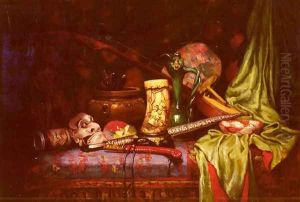Jules-Paul-Ernst Hedou Paintings
Jules-Paul-Ernst Hédou, born in 1849 in Rouen, France, was a French artist whose work spanned the realms of engraving and painting, reflecting the rich artistic traditions of the 19th century while also embracing the emerging styles of the early 20th century. He was part of a generation of artists who were pivotal in the transition from traditional to modern art forms, exploring new techniques and subject matters that pushed the boundaries of conventional aesthetics.
Hédou's early life was deeply influenced by the artistic heritage of Rouen, a city known for its gothic architecture and vibrant cultural scene. This environment nurtured his artistic talents, leading him to pursue formal education in the arts. He was particularly drawn to engraving, a field in which he would excel and make significant contributions. His work in this medium was characterized by meticulous attention to detail and a deep appreciation for the interplay of light and shadow, attributes that would define his artistic style.
Throughout his career, Hédou engaged with a variety of themes, from landscapes and urban scenes to portraits and historical subjects. His engravings often depicted the picturesque and the mundane with equal finesse, capturing the essence of French life and scenery. Moreover, his paintings, though less known than his engravings, displayed a keen sense of color and composition, showcasing his versatility as an artist.
Hédou's contributions to the art world were recognized in his time, and he participated in several exhibitions, gaining accolades and the admiration of his peers. Despite this, he remained somewhat outside the main currents of French art, dedicating himself to his craft without seeking the limelight. His works, however, have endured, offering insight into the transitional period of art at the turn of the 20th century.
Jules-Paul-Ernst Hédou passed away in 1908, leaving behind a body of work that continues to be appreciated for its beauty and historical value. His engravings, in particular, are sought after by collectors and admired in museum collections, serving as a testament to his skill and artistic vision. Hédou's legacy is that of an artist who bridged the old and the new, capturing the spirit of his time while paving the way for future generations.
